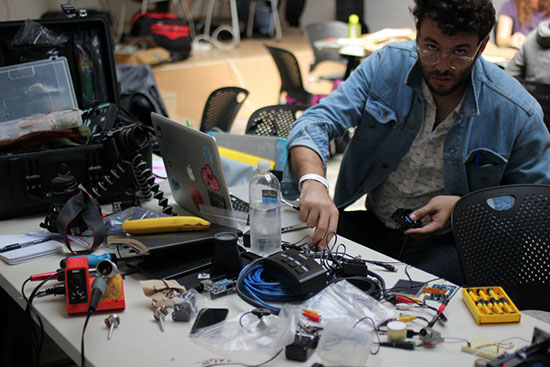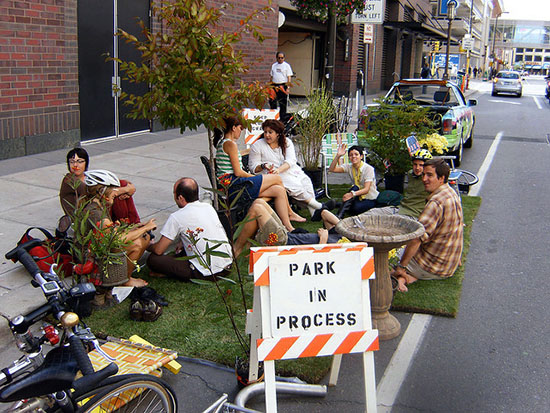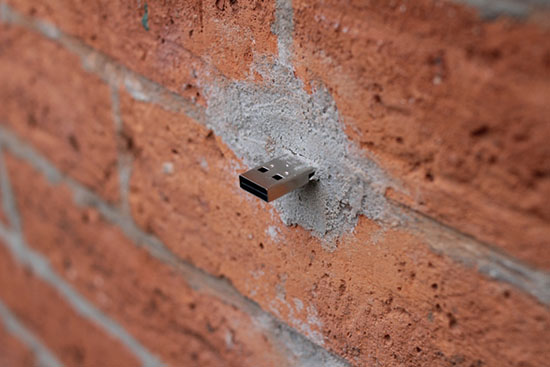San Francisco’s Makeathon Leads the Way for Hacking the Urban Landscape
How citizens are using design interventions to shuffle social dynamics and change public space in cities
![]()

Hack in progress at the Urban Prototyping Makeathon in San Francisco (image: sf. urbanprototyping.org)
Last weekend in San Francisco, a group of civic organizations hosted a 48-hour design makeathon that was meant to yield clever solutions for improving one of the city’s shadier districts. San Franciscans have a knack for giving nicknames to ever smaller chunks of the city, and this particular one—a portion of SoMa—is sometimes dubbed 5M, for its pivot point at the intersection of 5th and Mission Streets. It’s an area filled with opaque-doored massage parlors and SROs, where drug use is apparent and employment is not. It’s also home to a big redevelopment project-in-progress, which has as its anchor the San Francisco Chronicle building, a relic of last millennium’s publishing model that has largely ceded its role to the more current functions of a creative technology workspace.
The makeathon took place inside this building and at the nearby TechShop, but the design interventions were meant to target the streets outside. Teams formed on Friday night, and had two days to plot an act of tactical urbanism—a temporary or mobile design intervention that would engage citizens in shaping their own neighborhoods. At the end, teams were expected to present a working prototype of their idea.
I attended the public demo session on Sunday afternoon to see what the weekend had generated. Ideas included a sidewalk news ticker where passers-by could vote on the relative importance of world news headlines (self-described as “NYSE meets Reddit”); a solar-powered retail kiosk where “microentrepreneurs” could sell goods using mobile payments and pedestrians could charge their devices; a light projection installation that would put brightly lit art on the walls of dark alleys; a tiny stage for street buskers with motion-activated lighting and A/V; and a viewfinder hack that streams live video from another location into the lens of a public viewing platform (image above from that project). 10 projects were presented and five were selected to receive a small grant that will enable them to further develop their concept, readying it for the upcoming Urban Prototyping Street Festival. (All ideas can be seen here, winners demarcated with “UP Selection.”)
I left the demo with a combination of impressions. On one hand, it was great to see all these people spending their weekend on such an endeavor, applying their skills as coders and designers and makers to develop projects that could make the city a safer and more enjoyable place. On the other hand, it was hard to draw a direct line from these inspired ideas to the problems that currently plague the neighborhood. Projecting images in dark alleys makes them less dark, and adds a layer of art, but is the point to encourage more foot traffic in alleys? To send drug users packing to another location? Is the alley meant to be a thoroughfare or a gathering place? On the list of things that might make this pocket of SoMa friendlier, how much impact does a nighttime projection stand to make?

One of the many parklets from Park(ing) Day 2008 (image: Flickr, Sveden)
The idea of inviting citizens to participate in shaping their own neighborhoods has taken off in the last few years. One of the most inspired and most viral is the now internationally famous Park(ing) Day, organized by Rebar Group, in which people turn metered parking spaces into parklets for the day, paying the meter all the while but subverting its function. Park(ing) Day still gleams as an example of tactical urbanism because its approach is extremely simple and its outcome abundantly clear. City needs more public outdoor space? Here’s a plot of ground anyone can rent for a handful of coins. The unexpectedness and visibility of the parklets achieved that highly-sought goal of breaking down barriers between people, spurring interaction, and ultimately building community. They were also a great source of empowerment, demonstrating that anyone could transform their street with nothing but an empty parking space, a piece of astroturf and a few lawn chairs. The extent and expense of creating a parklet was up to its creators.
The alley project reminded me of an intervention staged in Paris in 2006 by a collective of architects known as Atelier d’Architecture Autogérée. The project, entitled Passage 56, occupied an interstitial space between two buildings. Unlike an alley, it did not need to act as a pass-through for vehicles, so the group was able to build a structure and plant greenery. Passage 56 became a community hub where citizens could garden, learn environmental building strategies, and see self-sufficient architecture in action. Though some money was required to build the project, its operation cost nothing.
Over in Milan, the annual Public Design Festival pops up among the frenzy of the city’s Design Week, encouraging urbanites to dig into the relationship between people and space, and to think about ways to deepen it through creative projects. These have included collective dining experiences, walking tours, public furniture and container gardens, and experiments with small-scale manufacturing. Many of the ingredients, methods, and products that have appeared during Milan’s similarly time-constrained intervention festival are the same as those that emerged from the Urban Prototyping makeathon. Networking, gaming, farming, skill-sharing, and performing are all great tools for shuffling the dynamics of public space. The question, to my mind, is whether deploying top layers of design thinking can penetrate the complex social and economic layers beneath. And how smoothing those layers in one place may wrinkle them in another.
At the Urban Prototyping Festival on October 20, the makeathon winners will present alongside another cluster of projects that were completed over a longer period and had time to tackle some of that complexity. One such project, called PPlanter, attempts to solve for public urination challenges in the city (which, if you’ve ever been to San Francisco, is a problem your nose cannot ignore). The PPlanter is a modular urinal and sink embedded with bamboo that acts as a biofilter for treating the waste. The designers imagine it being applicable in some of San Francisco’s new public entertainment spaces, as well as in areas where homeless populations have few restroom options.
Will it work? Hard to say. On the spectrum of urban interventions, it has the advantage of being practical and specific, addressing a well-known problem that gets in the way of public space being easy to enjoy. Its utility may also be its disadvantage, though, given the many real challenges of trying to improve public sanitation infrastructure.

An example of a digital dead drop (image: deaddrops.com)
One of my favorite presenters from the makeathon was a project called Dead Drop Noir. USB flash drives would be implanted as “dead drops” in little holes in brick walls, or gaps in a fence, loaded with chapters of a mystery novel. Participants read the first chapter online, looking for clues that will lead them to some place in the neighborhood where they’ll find a flash drive loaded up with the next chapter. Reading the book becomes an interactive scavenger hunt. The project doesn’t have overt social impact, but it has a simple incentive for getting citizens out into the urban environment, looking closely at overlooked corners. The byproduct, I’d assume, would be a greater interest in one’s own physical position in the city, and a better understanding of the connection between people and place.
/https://tf-cmsv2-smithsonianmag-media.s3.amazonaws.com/accounts/headshot/sarah-rich-240.jpg)
/https://tf-cmsv2-smithsonianmag-media.s3.amazonaws.com/accounts/headshot/sarah-rich-240.jpg)